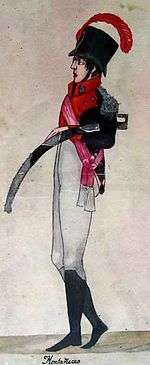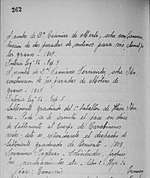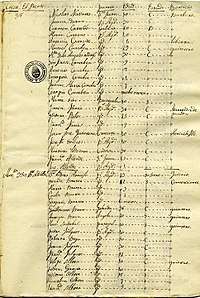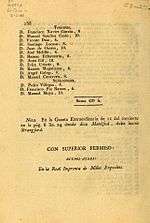Manuel Canaveris
Manuel Canaveris (1787–1830) was an Argentine army officer, who took part in the defense and reconquest of Buenos Aires during the English Invasions. He served under Colonel Ignacio Álvarez Thomas in the 4th Regiment of Buenos Aires, participating in the Campaigns to the Interior of the Provinces of 1810.[1]
Manuel de Canaveris | |
|---|---|
| Personal details | |
| Born | Manuel José Ramón Cornelio Jugluns de Canaveris 1787 Buenos Aires, Viceroyalty of Rio de la Plata |
| Died | 1830 Buenos Aires, Argentina |
| Nationality | Argentine |
| Political party | Confederationist |
| Spouse(s) | María de los Ángeles Rodríguez y Calderón de la Barca |
| Occupation | Army farmer trade |
| Profession | Militia |
| Awards | Standard-bearer |
| Signature |  |
| Military service | |
| Allegiance | |
| Branch/service | Militias of Buenos Aires |
| Years of service | 1806–1812 |
| Rank | Lieutenant |
| Unit | Tercio de Cántabros Montañeses Regimiento N° 4 de Infantería Regimiento de Patricios |
| Battles/wars | British invasions of the Río de la Plata Mutiny of Álzaga May Revolution War of Independence |
He also served in the garrison of the city as 2nd Lieutenant of the 7th Battalion of Fusiliers of the 2nd Regiment of Patricians. He and his family had an active participation during the British invasions of the River Plate and May Revolution. His father was one of the neighbors who attended the Open Cabildo of May 22, 1810.[2]
He was the only member of the Canaveris Esparza family to dedicate himself entirely to the militia. His sons were linked to families Blanco, Ferrer, Michelena, Pelliza and Torres, outstanding soldiers who served during the Argentine War of Independence.
Biography
He was born on September 15, 1787 in Buenos Aires, and was baptized the next day in the Metropolitan Cathedral by the presbyter Juan Antonio Delgado as Josse Manuel Cornelio Ramón Jugluns de Canaverys, being his godmother Juana Fonelo,[3] belonging to a family from Cádiz.[4] He was the eighth son of Juan Canaveris and Bernarda Catalina de Esparza. His family consisted of six brothers and six women, born between 1773 and 1797. They lived in a house located in the neighborhood of San Nicolás.[5]



Manuel Canaveris probably did his studies in the Real Colegio de San Carlos, the main educational establishment of the city. Some time later he and his brothers began to work as accounting employees of the Court of Accounts of Buenos Aires, where his father performed administrative functions.[6]
Like other members of his mother's family, Manuel served in the military. His mother's ancestors include Captains Miguel Gerónimo Esparza,[7] Francisco de Salas Reynoso, Pedro Morales y Mercado and Gonzalo Carbajal,[8] who served as General and Lieutenant Governor of Santa Fe.[9]
Manuel Canaveris and his brothers Mariano, Joaquín and José were members of the volunteer militias, for defense of Buenos Aires during the British invasions of the Río de la Plata 1806–1807. In the second British invasion Manuel Canaveris, had served in Tercio de Cántabros Montañeses, Mariano Canaveris served in Húsares of Pueyrredón, José Canaveris in the Quinteros y Labradores,[10] and Joaquín Canaveris in the Tercio de Vizcaínos, formed by volunteers of Basque origin.[11]
The Tercio de Cántabros Montañeses, also known as Tercio of Montañeses, had been created on September 18, 1806, and counted as chiefs José de la Oyuela and Pedro Andrés García, belonging to illustrious families of the city. At the beginning of the English invasions the battalion had 4 companies, with 261 troops.[12] During the second invasion the British commanders Robert Craufurd and Denis Pack, were defeated by Creole regiments of Montañeses and Patricios in the Convent of Santo Domingo.[13]
His father participated in the secret meetings of the neighbors during the British domination of Buenos Aires,[14] and also contributed money to cover the expenses of the Spanish militias of the city.[15] His brother Jose Canaveris, a well-known city lawyer, was awarded with the degree of Captain, by the Junta Suprema of Seville for his heroic actions during the English invasions.
Unlike his brothers, who were lawyers and teachers, he devoted himself entirely to the military career. Between 1809 and 1810, Canaveris was Sub-lieutenant Abanderado in the 4th Regiment of Infantry, formed by members of the "Tercio de Cántabros Montañeses" and Tercio de Andaluces. The Cántabros regiment was one of the units held by Viceroy Liniers, who repressed the rebels during Mutiny of Álzaga.[16] Canaveris served in the same regiment during the events of May 1810, and took part in the early years of the struggle for Independence in Argentina.[17]
Manuel Canaveris was promoted to Lieutenant of the 4th Regiment by order of the Primera Junta, on August 3, 1810.[18] He served under the orders of the Colonels José Merelo and Ignacio Álvarez Thomas,[19] and took part in the donations to finance the First Upper Peru campaign in 1810.[20]
As several members of the local aristocracy and bourgeoisie, he participated in the recruitment of slaves to enlist them in the revolutionary armies. In 1810 he rescued a freedman named Raimundo,[21] probably to be enlisted in the Regimiento de Castas, a military unit of freedmen recruited in Buenos Aires.[22]
In 1811 he obtains permission to marry his fiancee, Dona Maria de los Angeles Rodriguez Calderon de la Barca, after an extensive trial against his father.[23]
He possibly took part in the Liberating Expeditions to the Banda Oriental, during the military campaigns of the 4° Regiment against the Spanish troops in Montevideo.[24]
In 1812, Manuel Canaveris was commissioned to serve as 2nd lieutenant in the 7th Fusilier Company of 2nd Patrician Regiment,[25] participating in the campaigns to the north under the command of Colonel Francisco Ortiz de Ocampo.[26] Several regiments of Buenos Aires, including the riflemen of Patricians used the Brown Bess muskets, (known as "tower") which had been seized from the English invaders.[27]
Manuel Canaveris was retired from the Army at the age of 24 years, on January 17, 1812. He had served for six years, including his four years of service as Commander in the 2° Batallón del Regimiento N° 4 de Infantería of Buenos Aires, and in the 7° Compañía de Fusileros del Regimiento N°2 de Patricios.[28]
His family logistically supported the emancipation of the Argentine Republic. His brother Joaquín Canaveris participated in the donations for the regorganization of the Army of the North,[29] and his brother José Canaveris, provided services in the Honorable Junta de Observacion, and the Comisaria General de Guerra of the United Provinces of the Rio de la Plata.[30]
After the Argentine Declaration of Independence, Manuel Canaveris devoted himself entirely to commerce and agriculture. He owned a small ranch, probably located in Barracas or Balvanera. He died in 1830, as recorded in the deceased books of the parish of Monserrat.[31] His grandchildren and nephews are cited in the historical novel Amalia, written by José Mármol.[32]
Family

.jpg)
Manuel Canaveris, married at parish church Nuestra Señora de Montserrat on April 24, 1811, with María de los Ángeles Rodríguez, daughter of Basilio Rodríguez Rubio and Anselma Calderón de la Barca. His wedding was officiated by Juan Nepomuceno Solá, a personal friend of the family.[33] He and his wife were parents of Sinforoso, Antonino, María Juana, Eustaquia, Serapio, Rufino, Vicente and Ruperta Canaveri.[34]
Juan Ángel Michelena, son in law of Manuel Canaveris, was an officer of the Argentine army, who reached the rank of lieutenant colonel in 1852.[35] He served under the command of General José de San Martín, taking part in the Battle of Torata and Battle of Moquegua where he was taken prisoner.[36] Canaveris was also related to Francisco Pelliza, a patriot who served in the Army of the North.
His son, Sinforoso Canaveri Rodríguez was born on July 17, 1808 and was baptized in the parish Nuestra Señora de Montserrat on July 20 of the same year. He served as lieutenant in the ranks of the Federal Army. Towards the year of 1840 he integrated in the Batallón de Voluntarios Rebajados of Buenos Aires,[37] a military unit that was led by Joaquín Ramiro.[38]
Camilo Alejo Canavery, a great-grandson of Manuel Canaveris, was a lawyer who joined the rebel forces of the Civic Union during the Revolution of the Park.[39] He served as attorney of Enrique Mathet and José Camilo Crotto, governor of Buenos Aires Province between 1918 and 1921.[40]
The maternal grandmother of the Canaveris Rodríguez family was María Anselma Calderón de la Barca, daughter of Joseph Antonio Calderón and Margarita Taborda, a traditional Creole family descended from Spanish conquistadors, linked to families from Carmen de Areco, Exaltación de la Cruz and Rosario, Santa Fe. She died in 1829 in Buenos Aires, being buried in the Cementerio del Norte.[41]

Some of the grandchildren and great-grandchildren of Manuel Canaveris and María de los Ángeles Rodríguez were related to families Amaya, Durán, O'Gorman, Lemos, Rouquaud-Périchon and Terry's. His great-grandson, Virginio Canaveris was baptized on November 8, 1867, being his godson Manuel Terry Marmol, belonging to an old family from Buenos Aires.[42] Tomás O'Gorman attended as godfather at the wedding of his great-granddaughter María Luisa Canaveri with Damián Vera in 1879.[43]
His great-grandchildren Saturnino Canaveri and Isabelino Canaveris, held the rank of lieutenant colonels, having an active participation in military conflicts that occurred at the end of the 18th century in Argentina and Uruguay.
Like his ancestors, Manuel Canaveri 's family were fervent Christians. Most of his children and grandchildren were married or baptized in the Parish of Monserrat, including Guillermo Canavery, born on June 25, 1861 and baptized with that name in honor of Guillaume de Verceil.[44]
Several branches of his family were born or lived in the neighborhoods of San Cristóbal and Nueva Pompeya, but also in rural areas like Lincoln and Olavarría, place where a street with its surname is located.[45]
The name of Manuel Canaveris is registered in the edition of August 16, 1810, of Gazeta de Buenos Aires, the main newspaper of the city. Along with several members of his family, he appears registered in various publications concerning the colonial and postcolonial period of Argentina.[46]
References
- Il lavoro degli italiani nella Republica Argentina, dal 1516 al 1910: studi, leggende e riceche, Emilio Zuccarini
- Ensayo histórico sobre la revolución de mayo y Mariano Moreno:, El Ateneo, 1949
- Bautismos 1775–1791, Catedral de Buenos Aires
- Matrimonios 1656–1762, Catedral de Buenos Aires
- Genealogía, hombres de mayo, Revista del Instituto Argentino de Ciencias Genealógicas, 1961
- The Bureaucrats of Buenos Aires, 1769–1810: Amor Al Real Servicio, Susan Migden Socolow
- Acuerdos del extinguido Cabildo de Buenos Aires, Buenos Aires (Argentina). Cabildo; Biedma, José Juan
- Genealogía, Issue 13, Instituto Argentino de Ciencias Genealógicas 1961
- Historia de la Provincia del Chaco: Los fundadores, Carlos P. López Piacentini
- Invasiones inglesas al Río de la Plata 1806–1807, Marcos de Estrada
- Los Tercios Españoles en la Defensa de Buenos Aires (1807) (PDF), Horacio Guillermo Vázquez Rivarola
- Obras completas, Volume 10, Bartolomé Mitre
- Las invasiones inglesas del Río de la Plata (1806–1807) y la influencia inglesa en la independencia y organización de las provincias del río de la Plata, Carlos Roberts
- Ensayo histórico sobre la revolución de mayo y Mariano Moreno:, El Ateneo, 1949
- La reconquista y defensa de Buenos Aires, 1806-1807, Instituto de Estudios Históricos sobre la Reconquista y Defensa de Buenos Aires
- Historia de la República Argentina: su origen, su revolución y su desarrollo político hasta 1852, Volumen 1, Vicente Fidel López
- Registro nacional de la República argentina 1810/1821, República Argentina
- Tomas de razón de despachos militares, República Argentina
- Periodo dela independencia, año 1810, Archivo General de la Nación (Argentina)
- Documentos Para La Historia Del General Don Manuel Belgrano, Instituto Belgraniano Central (Buenos Aires, Argentina)
- Rescatadores de Libertos del Buenos Aires Colonial (1727–1811) (PDF), Eduardo Saguier
- Biblioteca del oficial, Volume 120, Military art and science
- Catálogo de nombres y materias:fichero general, 1544–1880, Archivo General de la Nación (Argentina)
- Revista de Buenos Aires: Historia Americana, literatura, derecho ..., Volume 17, Argentina
- Tomas de razón de despachos militares, cédulas de premio 1740 a 1821, Archivo General de la Nación (Argentina)
- Historia marítima argentina, Volumen5, Argentina. Departamento de Estudios Históricos Navales
- Boletín del Centro naval, Número 709, Argentina. Ministerio de Marina
- Registro nacional de la República argentina, Talleres gráficos de la penitenciaría nacional, 1879
- Gaceta de Buenos Aires, Volumen4, Compañía Sud-Americana de Billetes de Banco, 1912
- Acuerdos del extinguido Cabildo de Buenos Aires, Buenos Aires (Argentina) Cabildo
- Índice de defunciones, Parroquia de Monserrat
- Amalia, José Mármol
- Matrimonios 1769–1825, Nuestra Señora de Montserrat
- Genealogía, Números 13–15, Instituto Argentino de Ciencias Genealógicas, archived from the original on April 21, 2017
- Memoria, Parte 2, Argentina. Ministerio de Guerra y Marina
- Notas biográficas publicadas en la sección Efemérides americanas de "La Nación":, José Arturo Scotto
- Indice del Archivo del Departamento general de Policía, Buenos Aires – Departamento de Policía – Archivo
- Vida política de Juan Manuel de Rosas, a través de su correspondencia, Volume 4, Ediciones Trivium, 1970
- Crotto: historia de una ingratitud, Ernesto Quiroga Micheo, Ernesto Raúl Quiroga Vergara
- Crotto : historia de una ingratitud, Ernesto Quiroga Micheo, Ernesto Raúl Quiroga Vergara
- Defunciones 1801–1831, Nuestra Señora de Montserrat
- Bautismos 1866–1868, Parroquia Nuestra Señora de la Piedad
- Matrimonios 1879–1882, Nuestra Señora de la Piedad
- Bautismos 1860-1861, Nuestra Señora de Montserrat
- Geografía urbana de Olavarría, Parte1, I.I.A.O., 1987
- América, Volúmenes 1-2;Volumen 4, Argentina